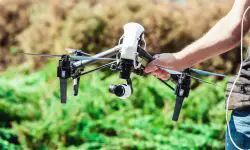As an Amazon Associate I earn from qualifying purchases.
People own drones for several reasons and one of the reason is for recreational purposes. Owning a drone for fun is one of the most exciting things for those who love outdoorsy activities. But all things like recreational, there are some rules and regulations that need to be adhered to in order to stay on the safe side, legally and health-wise. These rules apply across the board irrespective of your geographic location. We have outlined some of the most important rules that you must abide by when flying the recreational drone.
Observe The Altitudinal Limit And Stay Below It:
When flying your recreational drone, how high are you allowed to go? According to aviation authorities, the maximum allowable limit for recreational drones is 400 feet. This means that you are not allowed to fly your drone beyond this limit to avoid mid-air collision with manned aircraft such as planes. This height is equivalent to 121 meters Above Ground Level. This height is not uniform in all airspace and may vary from one jurisdiction to another. It is therefore advisable that you thoroughly check your air-map or seek advice from the aviation authority on what applies in your jurisdiction.
Keep Your Drone On Sight:
Ensure you can see your drone at all times with your naked eyes. Drones usually come with their own cameras and one may be tempted to rely on these for vision. This goes against the global best practices of recreational drones. While others may argue that using a binoculars to see your drone may fill the gap, you must ensure that you can see your drone in plain sight. Also, keep track of the local weather conditions as these may also affect your vision of the drone.
Keep The Drone Away From People:
While it may sound cool to fly your drone over people in order to capture the best overhead view, the general rule is that your drone should not be flown over people. This may be in a public beach or even in a stadium full of people watching football. Use your wisdom to fly the drone away from people in order to maintain the safety standards and ensure no one gets hurt.
Obey Your Community’s Guidelines:
While there are basic standards guidelines of flying recreational drones that apply across the board, each community might also have specific exceptions and laws regarding drone flight. You must therefore ensure you have all the rules and regulations regarding drone flying in your community. If your area of flight does not have any specific guidelines, then you should refer to the rules set by your country’s aviation industry.
Do Not Fly In The Dark:
This is the most basic and common rule of recreational drone flying. You should not fly your drone after dark. After dark terminology is usually used to refer to some 30 minutes before the sun rises or some 30 minutes after the sun has set. This rule also goes along with the rule about keeping your drone in sight. Flying in the dark means your vision of the drone is limited and you may not therefore be able to control the drone. In technical terms, these times before sunrise and after sunset are usually referred to as the civil twilight.
Give Notice To Airport Management If You Are Flying Close To An Airport:
There is a popular misconception that drones are not supposed to be flown close to the airport. However, this is not true. Depending on your country, flying close to an airport is not necessarily criminalized but you must give notice to the airport management if you intend to fly about 5 miles of an airport. Ensure you have the contact information of the airport management if you have plans of venturing close to an airport. This is to ensure the safety of all other aircraft users who might be within the airspace surrounding the airport.
All these rules apply to those who wish to fly their drones for fun. By sticking to these rules, you ensure your own safety and the safety of everyone else is guaranteed.
Amazon and the Amazon logo are trademarks of Amazon.com, Inc, or its affiliates.










